Monday, July 20, 2009
Final Drafts of Documentary Projects
Today (Monday, July 20), most of our class was able to meet in Winona, and connect with our colleagues in Tsaile, Arizona, via Interactive Television. We discussed each group's projects, made sure we had all release forms, rights forms and documentation. Then we looked at several of the projects that are near completion.
We saw several videos and some Soundslides projects which combine natural audio, music, text and still photographs into a multi-media presentation.
Wow! The projects are amazing. Thoughtful and insightful. After watching the pieces, we all felt we knew the elders featured a little better.
After we watched each piece, everyone offered constructive criticism. Only minor things need to be done to a few pieces; things like minor adjustments to sound volume or increasing the size of photo captions to ensure they are readable.
I know many blog readers are eager to see the results of the student's hard work. You'll get to see the projects as soon as possible. We still have an approval hurdle or two to clear before that can happen.
As part of seeking official clearance to do these projects on the Navajo Nation, we committed to show the projects to the Navajo Nation Human Research Review Board prior to any publishing.
The students will make final changes and edits to their pieces in the next couple weeks. Then, we'll take a week or so to prepare the packages that gather all the pieces into one easily-viewed DVD. We'll send copies of the DVD to the Tribal headquarters. It will take some time for the members of the HRRB to review all the materials. Professor Miranda Haskie of Diné College and myself will then appear before the board to hear their comments and seek their clearance.
Then, finally, we'll be able to publish the pieces, host celebration receptions, and give copies of the finished projects to the elders and their families.
We plan to publish the pieces on the WSU Mass Communication department's web site: Winona360.org. They'll also be given to Diné College, The Navajo Times, The Winona Daily News, The Navajo Nation Museum, and the Navajo Nation Library.
The students involved in this program have worked hard, from their initial research during spring semester well before our class began meeting, to the in-the-field interviews, and finally dozens and dozens of hours of transcribing, organizing, editing and producing their documentary projects. Their hard work has paid off... you'll see soon!
Monday, July 6, 2009
Chops Hancock: Many Faces of the Desert
William "Chops" Hancock lives in Winona, Minn., and is a semi-retired freelance photographer who works on projects that interest him both near and far. He has led a family citrus business in central Florida and worked as a photographer for National Geographic, Sports Illustrated, USA Today, Gannett Newspapers and many other publications.
He moved to Winona when he married his wife, Diana, and now serves on the Board of Directors of the Winona State University Foundation and the Mayo Foundation.
When he heard about the Winona State University Travel Study project to the Navajo Nation, he wanted to participate to record and document the activities of the students and the beauty of the people and the land.
This blog post contains a photo collection by Chops Hancock that he calls "Many Faces of the Desert."Several of these images are from the Chuska Mountains near Tsaile, Lukachukai and Cove, Arizona; a few are from around Window Rock, Arizona; several were created in Canyon Del Muerto, the northern fork of Canyon de Chelly in Arizona; and a few were taken in Chaco Culture National Historic Park, Chaco Canyon, near Nageezi, New Mexico.
Saturday, July 4, 2009
Editing, Re-writing, Proofreading
This week, students in the Navajo Oral Histories Travel Study class met twice via Interactive Television to look at first drafts of their projects and hear suggestions from each other for additional resources, improvements, edits, etc.

(photos by Chops Hancock)
The digital link between the Winona State University campus, in Winona, Minnesota, and the Diné College campus in Tsaile, Arizona, worked well. Students could see and hear each other, and we watched short video segments, viewed photographs, listened to audio samples, and watched a SoundSlides project.
The student projects are coming along very well. I was impressed with the effort the students have been putting into faithfully telling the stories of the Navajo elders while making the pieces interesting, and engaging. It is hard work, and sometimes tedious, to go through hours of interviews or hundreds of photos to choose the best material, then organize it into a meaningful piece of documentary journalism.
One of the strengths of our program is that the student teams each met with their elders several times and did a service project with and for the elders. A relationship of trust and respect was built between the students and the elders. I think this means the students take very seriously their responsibility to get the story right.
The students now have about two weeks to do further work on their projects and then submit a final draft in mid-July.
The faculty associated with the program will review the student projects and suggest additional edits or changes if necessary. Then, the projects will go to the Navajo Nation Human Research Review Board for review.
Plans call for the finished projects to be published in fall in conjunction with celebratory receptions. The projects will be published on the WSU Mass Communication's new web site: Winona360.org, and will be made available for publishing by the Navajo Times newspaper, the Winona Daily News, and Diné College.
Each elder featured in the projects will receive copies for their own use, and copies will be archived at both higher education institutions, and at the Navajo Nation Museum, and Navajo Nation Library.
I'm eager to see the finished projects -- I know they will be excellent.
Subscribe to:
Posts (Atom)

















































